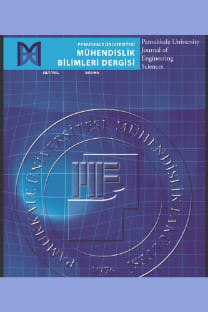HetNet için küçük hücre kullanıcı yoğunluğunun küçük hücre uyutma tekniği performansı üzerindeki etkisi
Heterojen ağlar, Kullanıcı yoğunluğu, Küçük Hücre, Makro Hücre, Trafik aktarma
Impact of small cell user density on performance of small cells sleeping technique for HetNet
Heterogeneous network, Macro cell, Small cell, Traffic offloading, User density,
___
- Auer G, Blume O, Giannini V, Godor I, Imran MA, Jading Y, Katranaras E, Olsson M, Sabella D, Skillermark P, Wajda W. “Earth project d2.3-energy efficiency analysis of the reference systems, areas of improvements and target breakdown”. Energy Aware Radio Network Technology (EARTH), 7, 1-68, 2012.
- Webb M. "SMART 2020: Enabling the low carbon economy in the information age". The Climate Group. London, England, 2008.
- Saker L, Elayoubi SE, Chahed T, Gati A. "Energy efficiency and capacity of heterogeneous network deployment in LTE-Advanced". European Wireless 2012; 18th European Wireless Conference 2012, Poznan, Poland, 18-20 April 2012.
- Zhang H, Chu X, Guo W and Wang S. "Coexistence of Wi-Fi and heterogeneous SC networks sharing unlicensed spectrum". IEEE Communications Magazine, 53(3), 158-164, 2015.
- Hwang I, Song B, Soliman SS. “A holistic view on hyper-dense heterogeneous and SC networks”. IEEE Communication Magazine, 51(6), 20-27, 2013.
- Ge X, Tu S, Mao G, Wang CX, Han T. “5G ultra-dense cellular networks”. IEEE Wireless Communications, 23(1), 72-79, 2016.
- Bhushan N, Li J, Malladi D, Gilmore R, Brenner D, Damnjanovic A, Sukhavasi R, Patel C, Geinhofer S. “Network densification: The dominant theme for wireless evolution into 5G”. IEEE Communications Magazine, 52(2), 82-89, 2014.
- Andrews JG, Buzzi S, Choi W, Hanly SV, Lozano A, Soong ACK, Zhang JC, “What Will 5G Be?”. IEEE Journal on Selected Areas in Communications, 32(6), 1065-1082, 2014.
- 3GPP. “ETSI Summit on Future Mobile and Standards for 5G”. http://www.3gpp.org/news-events/conferences/ 1515-etsi-summit-on-future-mobile-and (11.04.2018).
- Shakir MZ, Qarage KA, Tabassum H, Aloini MA, Serpedin E, Imran MA. "Green heterogeneous small-cell networks: Toward reducing the CO2 emissions of mobile communications industry using uplink power adaptation". IEEE Communications Magazine, 51(6), 52-61, 2013.
- Luo S, Zhang R, Lim TJ. "Optimal power and range adaptation for green broadcasting". IEEE Transactions on Wireless Communications, 12(9), 4592-4603, 2013.
- Vereecken W, Deruyck M, Colle D, Joseph W. Pickavet M., Martens L., Demeester P. "Evaluation of the potential for energy saving in macrocell and femtocell networks using a heuristic introducing sleep modes in base stations". EURASIP Journal on Wireless Communications and Networking, 170, 1-14, 2012.
- Cai S, Che Y, Duan L, Wang J, Zhou S, Zhang R. "Green 5G heterogeneous networks through dynamic small-cell operation". IEEE Journal on Selected Areas in Communications, 34(5), 1103-1115, 2016.
- Details are hidden under the double-sided privacy policy.
- Li L, Peng M, Yang, C, Wu Y. “Optimization of base-station density for high energy-efficient cellular networks with sleeping strategies”. IEEE Transactions on Vehicular Technology, 65(9), 7501-7514, 2016.
- Namdar M, Ilhan H, Durak-Ata L. “Dispersed chirp-z transform based spectrum sensing and utilization in cognitive radio networks”. IET Signal Processing, 8(4), 320-329, 2014.
- Che YL, Duan L, Zhang R. “Spatial throughput maximization of wireless powered communication networks”. IEEE Journal on Selected Areas in Communication, 33(8), 1534-1548, 2015.
- Samarakoon S, Bennis M, Saad W, Debbah M, Latva-aho M. "Ultra dense small cell networks: turning density into energy efficiency". IEEE Journal on Selected Areas in Communications, 34(5), 1267-1280, 2016.
- “Small cell enhancements for E-UTRA and E-UTRAN - Physical layer aspects”. 3rd Generation Partnership Project (3GPP), TR 36.872, 2013.
- ISSN: 1300-7009
- Yayın Aralığı: 7
- Başlangıç: 1995
- Yayıncı: PAMUKKALE ÜNİVERSİTESİ
Tarımsal alanlarda yüksek çözünürlüklü IKONOS uydu görüntüsünden nesne-tabanlı ürün deseni tespiti
Beste TAVUS, Kamil KARATAŞ, Mustafa TÜRKER
Uçan nesnelerin otomatik tespit ve takibi için yeni bir yaklaşım
Heterojen LTE ağlarda femto hücreler için güç yönetim eniyilemesi
Ahmet AKBULUT, Aykut KALAYCIOĞLU
Otomotiv akülerinde problem tespitine yönelik hücresel ölçüm ve hata teşhis sistemi
Osman DEMİRCİ, Burcu ACAR DEMİRCİ, Sezai TAŞKIN
Kutuplaştırılmış veri üzerinde ikili sınıflandırma için sürekli zamanlı eşik değeri belirleme
Ali SAĞLAM, Nurdan AKHAN BAYKAN
Yazılım geliştirme taleplerinin metin madenciliği yöntemleriyle önceliklendirilmesi
Murat Can TEKİN, Volkan TUNALI
Kararlı durumda seri kapasitörlerin iletim şebekesine etkilerinin incelenmesi
Doğan Can SAMUK, Fatih Mehmet NUROĞLU
İlişkisel veri tabanlarında XML veriler için Homoglif dönüşüm tabanlı damgalama
Mustafa Bilgehan İMAMOĞLU, Mustafa ULUTAŞ
Şebekeden bağımsız hibrit sistemin (rüzgar-fotovoltaik) performans analizi
